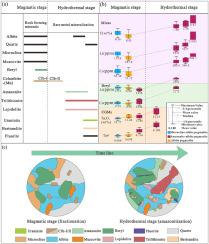Mineralization processes in the Yaotoushan rare metal deposit in northern Mufushan batholith, central China: Constraints from geochronology and mineralogy
IF 3.4
3区 地球科学
Q1 GEOCHEMISTRY & GEOPHYSICS
引用次数: 0
Abstract
The Mufushan area in central China represents a major concentration zone for rare metal ores. It has undergone a complete magmatic-hydrothermal evolutionary process, leading to the widespread distribution of pegmatite deposits. However, the genetic link between large batholith magmatism and rare metal mineralization remains unexplored, limiting the establishment of ore-forming models for such batholiths. The newly identified Yaotoushan rare metal deposit occurs at the contact between two-mica granite and the Lengjiaxi Group on the northern margin of the Mufushan batholith. The mineralized pegmatites in this deposit are classified as microcline-albite pegmatite, amazonite-albite pegmatite, and albite pegmatite. This study investigated the mineralogical features of these pegmatite types to constrain their metallogenic ages and elucidate the magmatic-hydrothermal evolution of the Yaotoushan system. Chronological and mineralogical evidence indicated two distinct metallogenic stages. The magmatic stage (127.6 ± 0.6 Ma) was characterized by Be–Nb–Ta mineralization. Fractional crystallization concentrated Be, Nb, and volatiles in the residual melt, producing Ta-poor columbite-(Mn) and beryl. This metallogenic age was defined by the U–Pb dating of columbite-(Mn). The subsequent hydrothermal stage (123.0 ± 1.1 Ma) involved Li mineralization combined with the secondary enrichment of Be, Nb, and Ta, as determined by the U–Th-Pbtotal chemical age of uraninite. The interaction between hydrothermal fluids and primary minerals markedly increased Li and F in micas and Cs in beryl, resulting in the crystallization of Ta-rich columbite-(Mn), trilithionite, lepidolite, and bertrandite. Quantitative analysis demonstrated that the transformation of beryl into bertrandite-enriched BeO was nearly threefold, confirming the critical role of hydrothermal activity in secondary rare metal enrichment. The hydrothermal fluid composition (Li, F, Cs, Ta) was consistent with the evolutionary trend of pegmatite melts, indicating derivation from late-stage magmatic fluid exsolution. Metasomatic processes facilitated the Be–Nb–Ta–Li mineralization. Additionally, a comparison with global LCT-type pegmatites suggests that the Yaotoushan deposit exhibited a similar degree of evolution and therefore possessed significant metallogenic potential for rare metals.

木浮山北段窑头山稀有金属矿床成矿过程:来自年代学和矿物学的制约
中国中部木浮山地区是稀有金属矿的主要富集带。经历了完整的岩浆-热液演化过程,形成了伟晶岩矿床的广泛分布。然而,大型岩基岩浆作用与稀有金属成矿之间的成因联系尚未探明,限制了此类岩基成矿模式的建立。新发现的姚头山稀有金属矿床产于木浮山北缘双云母花岗岩与冷家溪群的接触部位。该矿床的矿化伟晶岩可分为微斜-钠长伟晶岩、亚马逊-钠长伟晶岩和钠长伟晶岩。本文研究了这些伟晶岩类型的矿物学特征,以约束它们的成矿时代,阐明姚头山体系的岩浆-热液演化。年代学和矿物学证据表明成矿阶段明显不同。岩浆期(127.6±0.6 Ma)以Be-Nb-Ta矿化为特征。分步结晶使残余熔体中的Be、Nb和挥发物富集,生成贫ta柱状-(Mn)和绿柱石。该成矿年龄由柱岩-(Mn)的U-Pb定年确定。在随后的热液阶段(123.0±1.1 Ma),铀矿的U-Th-Pbtotal化学年龄确定了Li矿化和Be、Nb、Ta的二次富集。热液与原生矿物的相互作用使云母中的Li和F含量显著增加,绿柱石中的Cs含量显著增加,形成富ta的柱长石-(Mn)、三硫代石、锂云母和铍黄铁矿的结晶。定量分析表明,绿柱石转化为富集铍黄铁矿的BeO的过程接近3倍,证实了热液活动在稀有金属次生富集中的关键作用。热液组成(Li、F、Cs、Ta)与伟晶岩熔体的演化趋势一致,表明源自晚期岩浆溶蚀。交代作用促进了Be-Nb-Ta-Li成矿作用。此外,与全球lct型伟晶岩对比表明,姚头山矿床演化程度相似,具有重要的稀有金属成矿潜力。
本文章由计算机程序翻译,如有差异,请以英文原文为准。
求助全文
约1分钟内获得全文
求助全文
来源期刊

Applied Geochemistry
地学-地球化学与地球物理
CiteScore
6.10
自引率
8.80%
发文量
272
审稿时长
65 days
期刊介绍:
Applied Geochemistry is an international journal devoted to publication of original research papers, rapid research communications and selected review papers in geochemistry and urban geochemistry which have some practical application to an aspect of human endeavour, such as the preservation of the environment, health, waste disposal and the search for resources. Papers on applications of inorganic, organic and isotope geochemistry and geochemical processes are therefore welcome provided they meet the main criterion. Spatial and temporal monitoring case studies are only of interest to our international readership if they present new ideas of broad application.
Topics covered include: (1) Environmental geochemistry (including natural and anthropogenic aspects, and protection and remediation strategies); (2) Hydrogeochemistry (surface and groundwater); (3) Medical (urban) geochemistry; (4) The search for energy resources (in particular unconventional oil and gas or emerging metal resources); (5) Energy exploitation (in particular geothermal energy and CCS); (6) Upgrading of energy and mineral resources where there is a direct geochemical application; and (7) Waste disposal, including nuclear waste disposal.
 求助内容:
求助内容: 应助结果提醒方式:
应助结果提醒方式:


